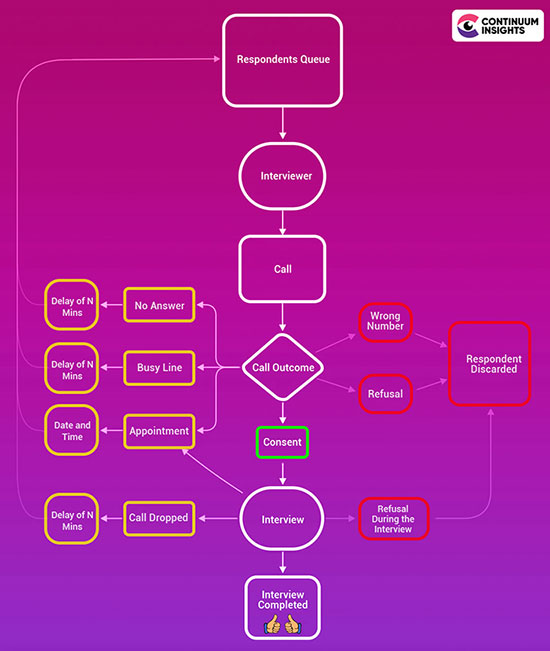CATI, also known as Computer-Assisted Telephone Interviewing, is a research survey method involving an interviewer asking participants a set of questions over the phone. The interviewer records the answers provided by the participants using a software system, which can be programmed to record responses automatically in real time.
CATI surveys are commonly used in market research, political polling, and academic studies and offer a convenient and cost-effective way of collecting data from a large sample of participants.
LET US UNDERSTAND IN SIMPLE LANGUAGE
Imagine you bought any product. After purchasing the product, you receive a phone call from someone conducting an interview. They ask you some questions and request feedback related to the product you purchased. Additionally, they inquire about your service experience and feedback from where you made your purchase. They gather all this data during the call. This type of phone call is known as a Computer Assistant telephone interview OR CATI phone survey.
Why is CATI The Best?
Computer-Assisted Telephone Interviewing (CATI) represents a more effective approach compared to the traditional paper-and-pen method in various aspects. Through CATI survey organizations can engage directly with respondents and gather feedback via telephone interviews. Furthermore, the CATI survey method streamlines the process of managing and analyzing responses. These advantages ultimately contribute to fostering improved relationships and obtaining more valuable feedback between survey organizations and their respondents
How Does CATI Work
CATI is a survey research method that collects data through telephone interviews. Here's how it works:
- Questionnaire Design
- Sample Selection
- Telephone Calls
- Real-time Data Entry
- Data Management
- Data Analysis
Questionnaire Design: Researchers design a structured questionnaire that includes a set of questions to gather the required information. The questionnaire is programmed into a computer system.
Sample Selection: A sample of individuals is chosen to participate in the survey. This sample is often representative of the larger population under study.
Telephone Calls: Trained interviewers make phone calls to the selected participants. The computer system assists the interviewer by displaying the questions on a screen.
Real-time Data Entry: During the telephone interview, the interviewer enters the participant's responses directly into the computer system.
Data Management: The data collected is stored electronically, facilitating efficient management, analysis, and reporting. The electronic format enables faster and more precise data processing.

Advantages of CATI
Here are some benefits of using CATI:
Efficiency: When conducting phone interviews, using CATI can save time. CATI telephone surveys automate the process by helping with dialing, record-keeping, and data entry. This reduces the amount of time needed for each interview.
Accuracy: The computer system helps to avoid mistakes by consistently asking questions and recording data. This results in more reliable and accurate information being collected.
Adaptability: CATI systems can be easily programmed to skip irrelevant questions based on previous responses, making interviews more tailored and efficient. This adaptability ensures a more focused and respondent-friendly experience.
Cost-Effective: While there might be initial setup costs, CATI can be more cost-effective in the long run due to increased efficiency and reduced labour hours. It also eliminates the need for paper surveys and manual data entry.
Data Security: Cati survey software offers secure data storage and backup, reducing the risk of data loss. Access to sensitive information can be controlled, ensuring the confidentiality and privacy of the respondents.
Survey Script Control: Researchers can easily modify survey scripts and questionnaires, making it convenient to update surveys or adapt to changing research needs. This flexibility is crucial in dynamic research environments.
Although CATI surveys offer numerous benefits, But here are some key challenges associated with CATI survey research:
Challenges of CATI Survey Research
Declining Response Rates: With an increasing number of unsolicited calls and privacy concerns, people are becoming more reluctant to participate in telephone surveys. According to studies from the PEW Research Center, response rates have decreased significantly over the years, falling from 36% to just 6%. This decline in response rates has profoundly affected the representativeness and reliability of the data collected.
Sampling Issues: CATI surveys rely on random or targeted sampling methods to ensure a representative sample. However, reaching certain demographic groups can be challenging, leading to potential biases in the survey results.
Cell Phone Usage: The prevalence of cell phones has grown, and many people no longer have landline phones. CATI surveys may struggle to include individuals who exclusively use cell phones, leading to the underrepresentation of this demographic.
Survey Length and Fatigue: Participants may experience fatigue, especially when surveys are lengthy. This can lead to incomplete or inaccurate responses, impacting the overall quality of the collected data.
Interviewer Effects: The success of CATI surveys can be influenced by the skills and characteristics of the interviewers. Variations in the interviewer's demeanour, experience, or language proficiency can introduce biases and affect CATI data collection quality.


If you are interested in learning more about CATI,
We
are here to help you.
What Is the Difference Between CAPI and CATI?
CAPI (Computer-Assisted Personal Interviewing) and CATI (Computer-Assisted Telephone Interviewing) are both survey methods that use computer software to facilitate data collection.
The main difference between the two methods is in how the interviews are conducted. CAPI surveys are conducted face-to-face, while CATI surveys are conducted over the phone.
| In CAPI surveys | In CATI surveys |
|---|---|
| the interviewer enters the respondent's answers directly into a computer or tablet. This method can be useful for complex surveys where skipping patterns are required or for surveys that involve visual aids. | the interviewer reads the questions over the phone and enters the respondent's answers directly into a computer. This method can be faster and more cost-effective than face-to-face interviews but may be limited in terms of question complexity and visual aids. |
Both CAPI and CATI have their advantages and disadvantages, and the choice of which method to use will depend on the specific research objectives and resources available.
I hope you have understood what CATI survey is. Along with this it is also very important for you to understand digital surveys, so let's start digital surveys.
CATI Surveys Vs Digital Surveys
CATI surveys, use a computer program to assist the interviewer in conducting the survey over the phone. The interviewer asks the questions and inputs the respondent's answers into the computer program in real-time.
On the other hand, Digital surveys are conducted online through various platforms such as email, social media, chatbots, in-app, WhatsApp, or dedicated survey websites. Respondents can answer the survey questions at their own convenience and the results are automatically collected and analysed by the CATI survey tool .
Both CATI and digital surveys have their own set of advantages and disadvantages. While CATI surveys are useful for gathering detailed information from a specific group of respondents, they can be costly and take up a lot of time. On the other hand, digital surveys are more cost-effective and can reach a larger audience, but they may suffer from response bias and lack the personal interaction that comes with interviewing respondents over the phone.
Conclusion
CATI surveys are phone-based surveys conducted using computer software for data collection. They have been popular for large sample sizes and quick data collection. However, with digital technology, CATI surveys have become less viable, and online surveys have become more preferred for their convenience, accessibility, and real-time insights.
Continuum Insights specializes in helping businesses transition from traditional CATI surveys to digital surveys, with services that include survey design, development, data collection, analysis, and reporting.

